المجلة: Nature Communications، المجلد: 15، العدد: 1
DOI: https://doi.org/10.1038/s41467-024-47612-x
PMID: https://pubmed.ncbi.nlm.nih.gov/38615115
تاريخ النشر: 2024-04-13
DOI: https://doi.org/10.1038/s41467-024-47612-x
PMID: https://pubmed.ncbi.nlm.nih.gov/38615115
تاريخ النشر: 2024-04-13
إطار معدني عضوي قائم على الألمنيوم ذو جدران مزدوجة ومساحة سطح ميكروية محددة كبيرة لامتصاص البنزين بكميات ضئيلة
تاريخ الاستلام: 1 نوفمبر 2023
تم القبول: 2 أبريل 2024
نُشر على الإنترنت: 13 أبريل 2024
(أ) التحقق من التحديثات
تم القبول: 2 أبريل 2024
نُشر على الإنترنت: 13 أبريل 2024
(أ) التحقق من التحديثات
إطارات معدنية عضوية مزدوجة الجدران (MOFs)، تم تصنيعها باستخدام الزنك والكوبالت، هي مواد مسامية محتملة لامتصاص البنزين بكميات ضئيلة. الألمنيوم يتمتع بانخفاض السمية ووفرة في الطبيعة، مقارنةً بالزنك والكوبالت. لذلك، تم تطوير إطار MOF مزدوج الجدران قائم على الألمنيوم، يسمى ZJU-520(Al)، مع مساحة سطح محددة ميكروية كبيرة من
إطارات معدنية عضوية مزدوجة الجدران (MOFs)، مثل BUT-53(Co) إلى BUT-57(Co)
في هذا السياق، تم تخليق إطار معدني عضوي قائم على الألمنيوم ذو جدارين، يسمى ZJU-520(Al)، بواسطة سلسلة لولبية من
النتائج
التحليل الهيكلي
بلورات ZJU-520(Al) على شكل قضبان (الشكل التوضيحي 1)، مع نقاء عالٍ بسبب توافق الأشعة السينية البودرة النظرية.
أنماط الحيود (PXRD) مع الأنماط التجريبية للـ PXRD (الشكل التوضيحي 2)، والتي يمكن توسيعها بسهولة. ZJU-520(Al) في النظام البلوري الرباعي الزوايا مع
المساحة السطحية المحددة والاستقرار
ZJU-520(Al) يظهر مساحة سطح خاصة (
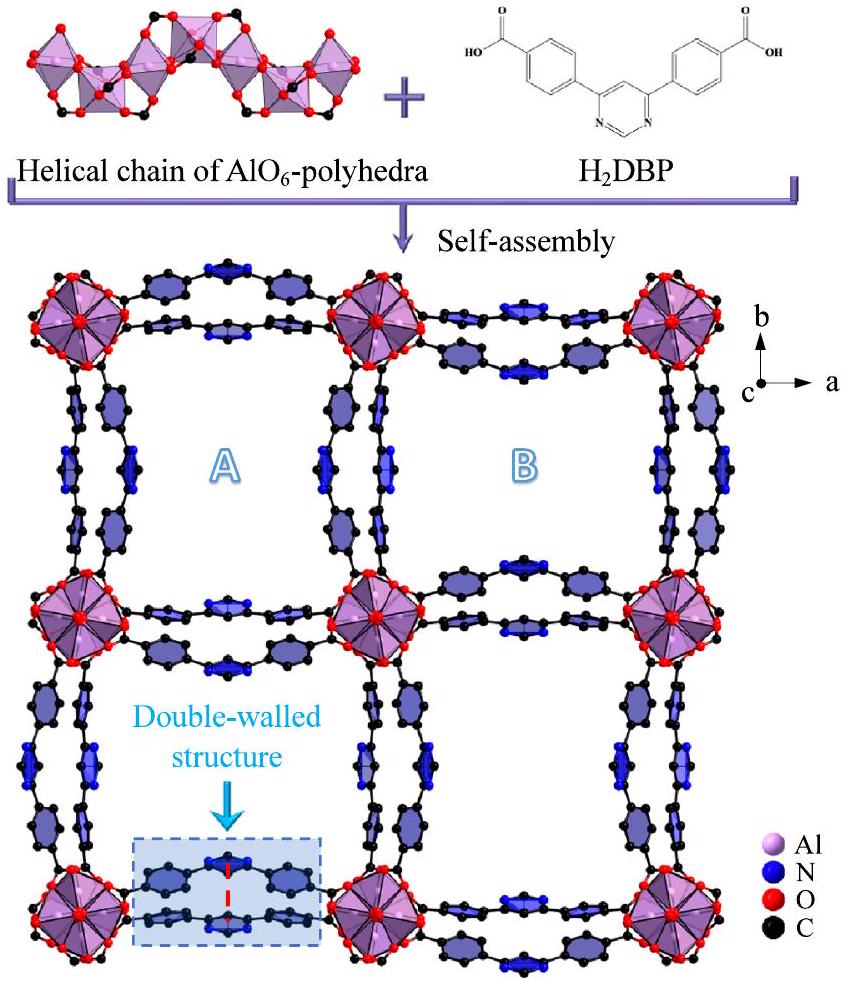
الشكل 1 | التركيب البلوري لـ ZJU-520(Al). وصف التركيب للـ ZJU-520(Al) ذو الجدران المزدوجة، مع نوعين من المسام الدقيقة (المسمات A و B)، يتكون من سلسلة لولبية من
نطاق
ZJU-520(Al) يتمتع بالاستقرار الحراري حتى
الامتصاص الثابت والديناميكي
تركيز البنزين في trace هو عند الضغط المنخفض (
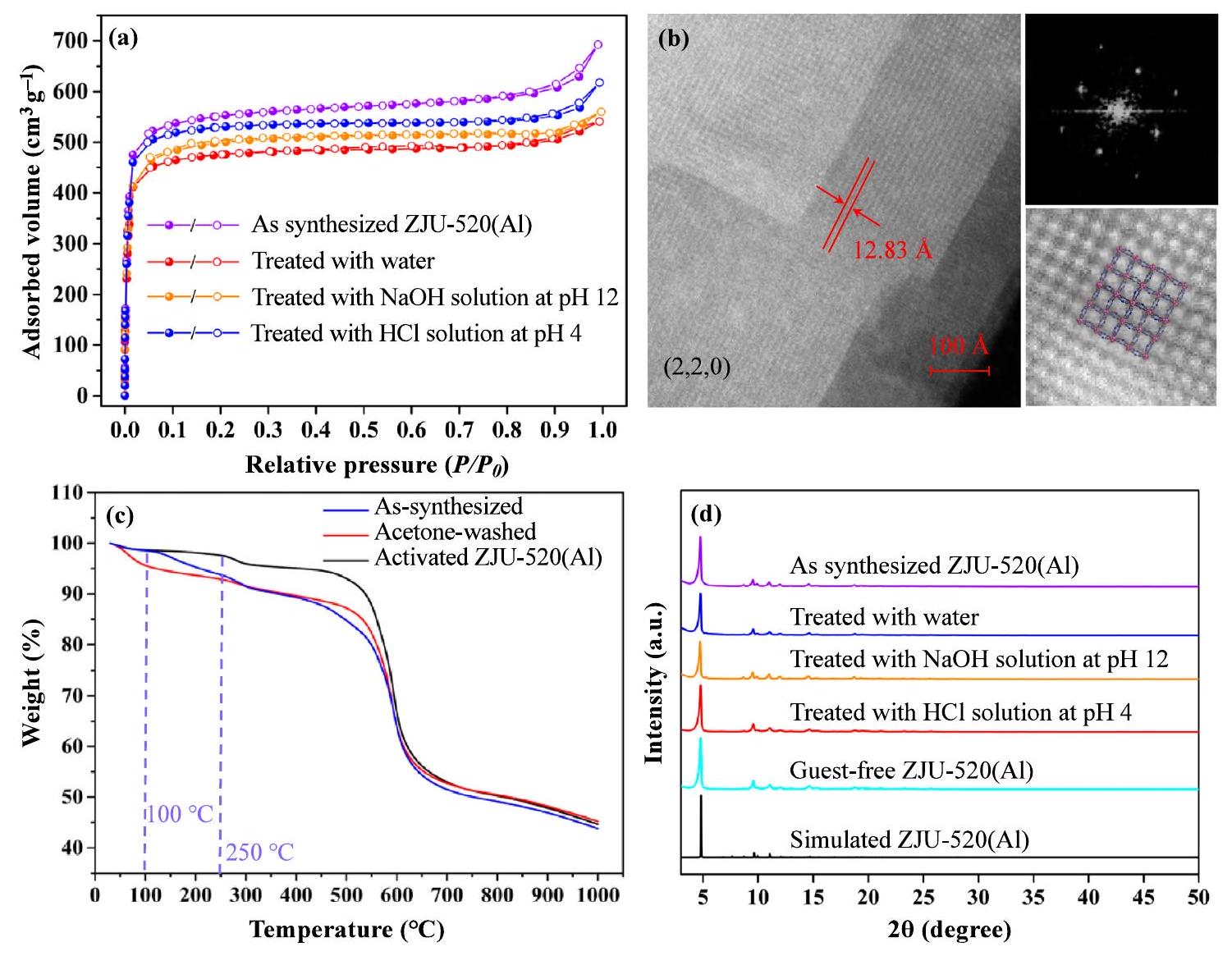
الشكل 2 | المساحة السطحية المحددة والاستقرار لـ ZJU-520(Al).

الشكل 3 | الامتزاز الثابت. منحنيات امتزاز BTEX والسيكلوهكسان بواسطة ZJU-520(Al) عند 298 كلفن مع
قدرة التجديد، بسبب امتصاص البنزين دون فقدان واضح على الأقل 4 مرات (الشكل 4c) وإطارها مع التكامل بسبب أنماط PXRD لـ ZJU-520(Al) دون تغييرات واضحة (الشكل التكميلية 14) بعد تجارب امتصاص-إزالة البنزين الدورية.
حرارة الإيزوستيريك
تركيز، بما يتماشى مع نظير الامتصاص للبنزين من النوع الأول (الشكل 3أ). علاوة على ذلك،
تركيز، بما يتماشى مع نظير الامتصاص للبنزين من النوع الأول (الشكل 3أ). علاوة على ذلك،
تبلغ كميات امتصاص البنزين الديناميكية لـ ZJU-520(Al) عند 10 و 1000 جزء في المليون 0.56 و
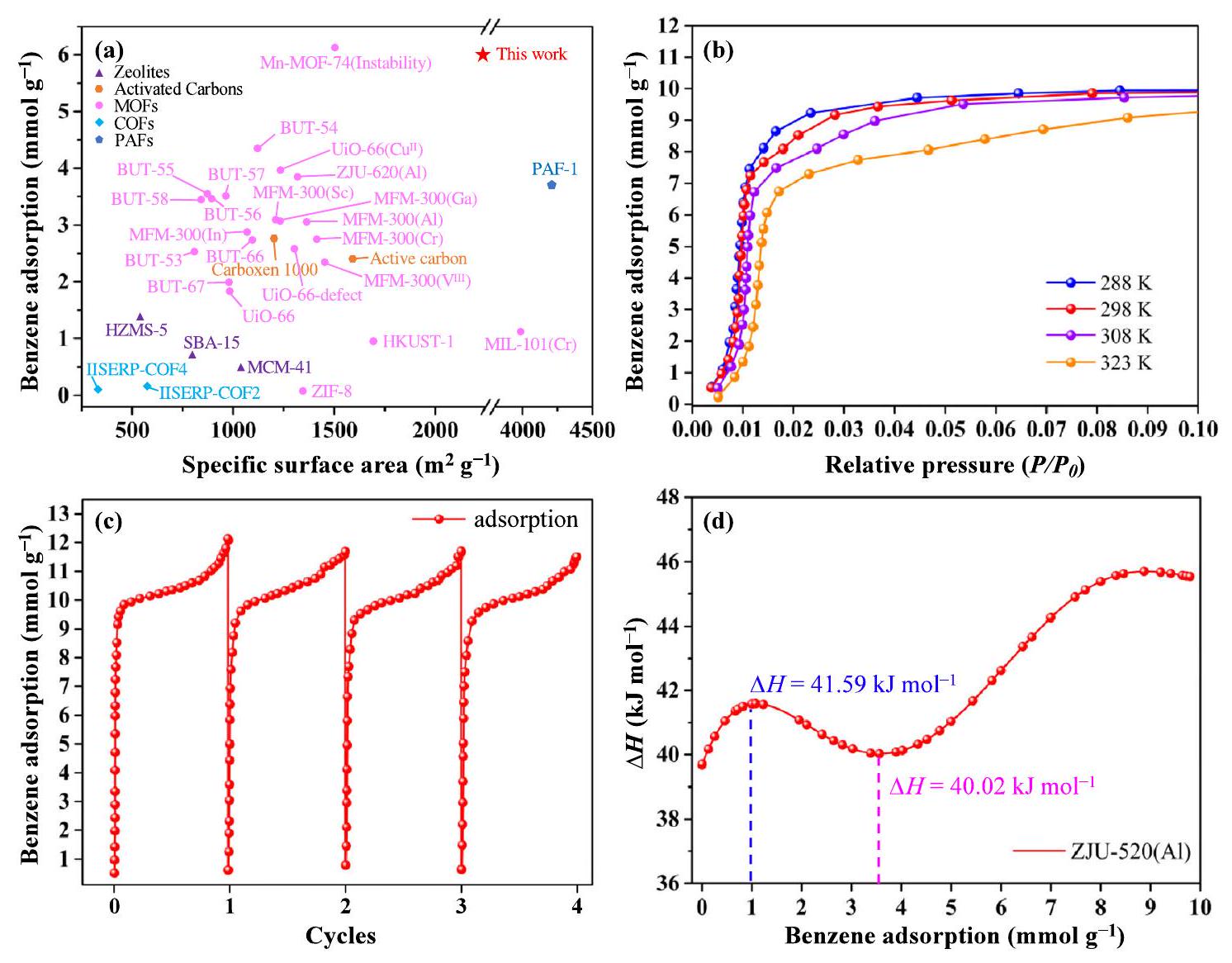
الشكل 4 | خصائص امتصاص البنزين. امتصاص البنزين عند 298 كلفن و
نُسب إلى ZJU-520(Al) بخصائص هيدروفوبية داخلية ضعيفة
آلية الامتزاز
تم إجراء محاكاة GCMC للحصول على رؤى حول مواقع امتصاص البنزين على ZJU-520(Al). قبل محاكاة GCMC، تم استخراج الشحنات الجزئية لـ ZJU-520(Al) والمواد الممتصة، مثل البنزين والتولوين، من الطريقة الكيميائية المستندة إلى الكثافة.
حتى 0.01 ، لاحتلال الموقع II (الشكل 5ب) بسبب
حتى 0.01 ، لاحتلال الموقع II (الشكل 5ب) بسبب
يمكن أيضًا تفسير الامتزاز التفضيلي لجزيئات البنزين في الموقع I (الشكل 5a) من خلال طاقة الربط المحسوبة.
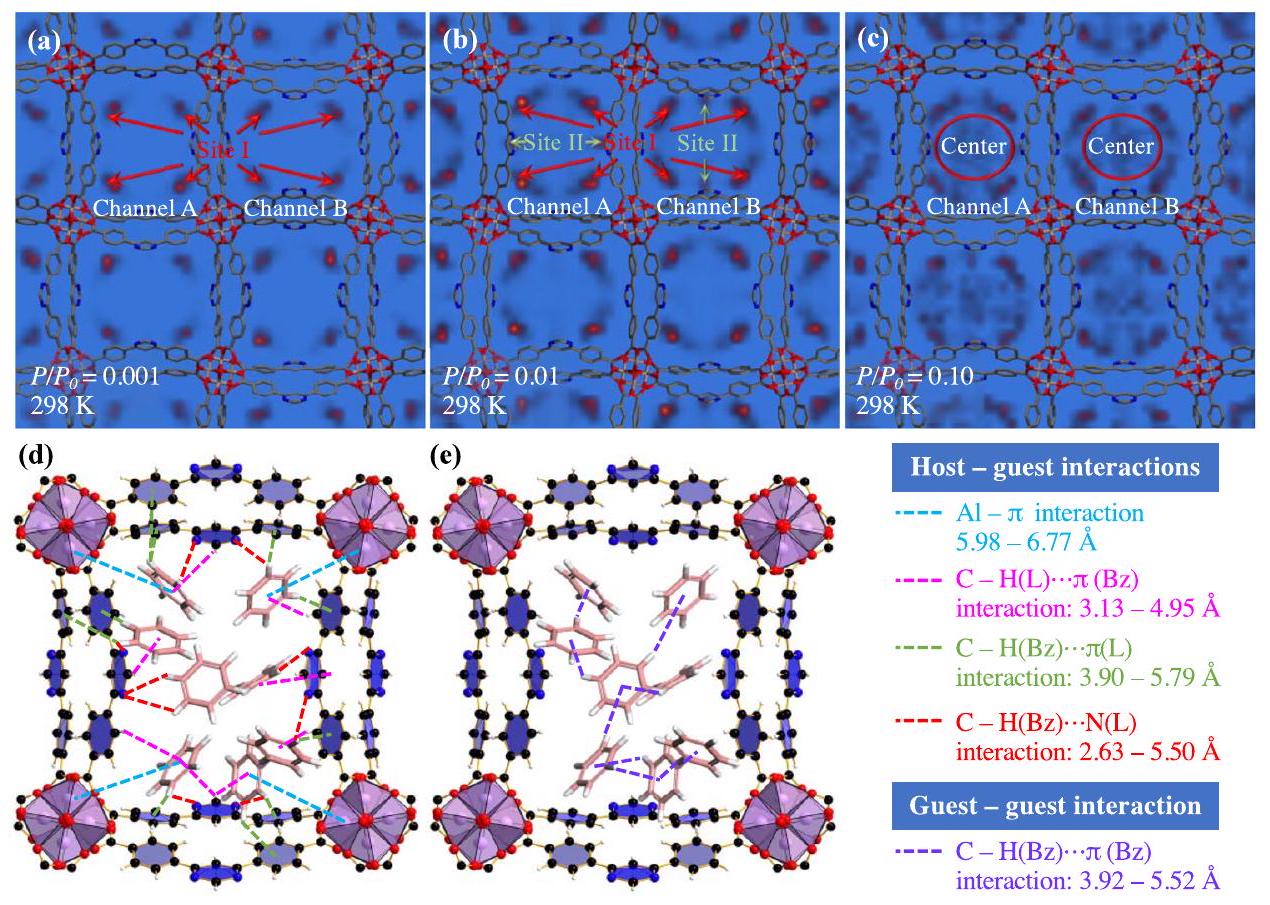
الشكل 5 | آلية امتصاص البنزين. الحقول المحتملة للبنزين على ZJU-520(Al) عند
محسوب بناءً على دور الهيكل منخفض الطاقة لـ ZJU-520(Al) مع جزيئات البنزين الممتصة، باستخدام طريقة حساب نظرية الكثافة الوظيفية
فصل البنزين والسيكلوهكسان
فصل البنزين (Bz) عن السيكلوهكسان (Cy) هو مهمة صعبة في الصناعات مثل إنتاج النايلون.
(الشكل التكميلي 28أ)، تم حسابه من إيزوثرم البنزين (الشكل 4ب) وإيزوثرم السيكلوهكسان (الشكل التكميلي 28ب) عند درجات حرارة مختلفة. باستخدام محاكاة GCMC متعددة المكونات لامتصاصات البنزين والسيكلوهكسان
(الشكل التكميلي 28أ)، تم حسابه من إيزوثرم البنزين (الشكل 4ب) وإيزوثرم السيكلوهكسان (الشكل التكميلي 28ب) عند درجات حرارة مختلفة. باستخدام محاكاة GCMC متعددة المكونات لامتصاصات البنزين والسيكلوهكسان
نقاش
ZJU-520(Al)، كإطار معدني عضوي قائم على الألمنيوم مزدوج الجدران، يظهر مساحة سطح ميكروية محددة كبيرة من
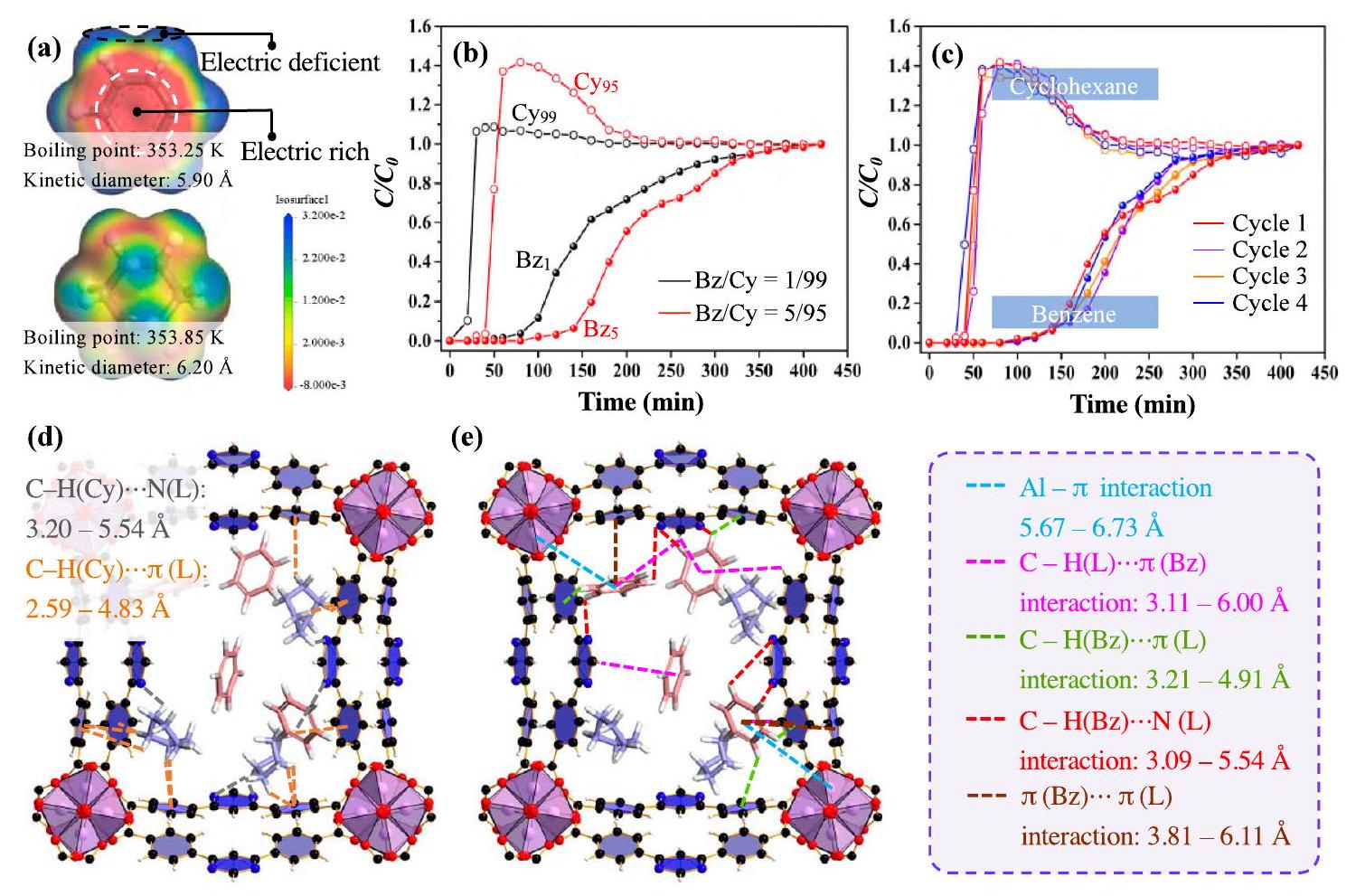
الشكل 6 | تجارب الامتزاز الديناميكي للبنزين والسيكلوهكسان. الخصائص الفيزيائية للبنزين والسيكلوهكسان (أ)، منحنيات الاختراق لفصل البنزين/السيكلوهكسان (ب)، فصول دورية للبنزين/السيكلوهكسان (ج) على ZJU-520(Al)، وتفاعلاته مع السيكلوهكسان (د) والبنزين (هـ).
يمكن أن يكون ZJU-520(Al) مادة محتملة لامتصاص البنزين بكميات ضئيلة وفصل البنزين/سيكلوهكسان.
طرق
المواد الكيميائية والمواد
تم شراء جميع المواد الكيميائية التجارية دون أي تنقية إضافية. 4,6-دي(4-كربوكسي فينيل) بيريميدين (
زجاج زيو-520(أل)
قبل قياس الامتصاص، تم تسخين العينات عند 378 كلفن لمدة 24 ساعة في بيئة فراغ. تم حساب المساحة السطحية المحددة لـ ZJU-520(Al) بطريقة BET في النطاق من 0.001-0.053.
التحليل الجاذبي الحراري
تم الحصول على عينات ZJU-520(Al) التي تم تصنيعها من الطرد المركزي، وتم تسخينها عند
الامتصاص الثابت
تم قياس منحنيات امتصاص بخار البنزين، التولوين، الإيثيل بنزين، الميتا-زيلين، الأورثو-زيلين، والبارا-زيلين (BTEX)، السيكلوهكسان، والماء بواسطة جهاز امتصاص بخار JW-ZQ100 (شركة بكين JWGB للعلوم والتكنولوجيا، الصين). تم توليد الأبخرة بواسطة وحدة توليد البخار ووحدة التسخين. قبل القياس، تم تنقية السوائل الممتصة عند 77 كلفن في النيتروجين السائل، على التوالي.
تجربة الاختراق الديناميكي
تم خلط حوالي 0.10 جرام من ZJU-520(Al) المنشط مع صوف الكوارتز بشكل موحد ووضعه في السرير الثابت (بقطر خارجي 6.00 مم، وقطر داخلي 4.00 مم، وطول 130.00 مم) لإجراء تجربة اختراق ديناميكي للبنزين/سيكلوهكسان (Bz/Cy) عند 298 كلفن، باستخدام محلل منحنى اختراق الامتصاص متعدد المكونات (BSD-MAB،
شركة بي إس دي إنسترومنت المحدودة، الصين). تدفق الغاز عالي النقاء
ملخص التقرير
معلومات إضافية حول تصميم البحث متاحة في ملخص تقرير Nature Portfolio المرتبط بهذه المقالة.
توفر البيانات
تم إيداع بيانات الامتصاص الثابت لـ ZJU-520(Al) (الشكل 3). يتم توفير بيانات المصدر مع هذه الورقة.
References
- He, T. et al. Trace removal of benzene vapour using double-walled metal-dipyrazolate frameworks. Nat. Mater. 21, 689-695 (2022).
- Lenzen, D. et al. A metal-organic framework for efficient waterbased ultra-low-temperature-driven cooling. Nat. Commun. 10, 1-9 (2019).
- Woellner, M. et al. Adsorption and detection of hazardous trace gases by metal-organic frameworks. Adv. Mater. 30, 1704679-1704685 (2018).
- Hu, L. et al. A novel aluminum-based metal-organic framework with uniform micropores for trace BTEX adsorption. Angew. Chem. Int. Ed. 62, e202215296 (2023).
- Boyd, P. G. et al. Data-driven design of metal-organic frameworks for wet flue gas
capture. Nature 576, 253-256 (2019). - Zheng, Z. et al. ChatGPT chemistry assistant for text mining and the prediction of MOF synthesis. J. Am. Chem. Soc. 145, 18048-18062 (2023).
- Wang, H. et al. Sensing and capture of toxic and hazardous gases and vapors by metal-organic frameworks. Chem. Soc. Rev. 47, 4729-4756 (2018).
- Pei, J. et al. Dense packing of acetylene in a stable and low-cost metal-organic framework for efficient
separation. Angew. Chem. Int. Ed. 60, 25068-25074 (2021). - Lenzen, D. et al. Scalable green synthesis and full-scale test of the metal-organic framework CAU-10-H for use in adsorption-driven chillers. Adv. Mater. 30, 1705869-1705878 (2018).
- Ghalei, B. et al. Enhanced selectivity in mixed matrix membranes for
capture through efficient dispersion of amine-functionalized MOF nanoparticles. Nat. Energy 2, 17086-17095 (2017). - Vismara, R. et al.
adsorption in a robust iron(III) pyrazolatebased MOF: molecular-level details and frameworks dynamics from powder X-ray diffraction adsorption isotherms. Adv. Mater. 12, 2209907-2209923 (2023). - Knebel, A. & Caro, J. Metal-organic frameworks and covalent organic frameworks as disruptive membrane materials for energyefficient gas separation. Nat. Nanotechnol. 17, 911-923 (2022).
- Cho, H. S. et al. Isotherms of individual pores by gas adsorption crystallography. Nat. Chem. 11, 562-570 (2019).
- Wang, Z. et al. Microporous polymer adsorptive membranes with high processing capacity for molecular separation. Nat. Commun. 13, 4169-4178 (2022).
- Zhang, J. et al. Embedded nano spin sensor for in situ probing of gas adsorption inside porous organic frameworks. Nat. Commun. 14, 4922-4932 (2023).
- Connolly, M. L. Solvent-accessible surfaces of proteins and nucleic acids. Science 221, 709-713 (1983).
- Ikezoe, Y. et al. Autonomous motors of a metal-organic framework powered by reorganization of self-assembled peptides at interfaces. Nat. Mater. 11, 1081-1085 (2012).
- Song, Y. et al. High-yield solar-driven atmospheric water harvesting of metal-organic framework derived nanoporous carbon with fastdiffusion water channels. Nat. Nanotechnol. 17, 857-863 (2022).
- Matemb Ma Ntep, T. J. et al. When polymorphism in metal-organic frameworks enables water sorption profile tunability for enhancing heat allocation and water harvesting performance. Adv. Mater. 12, 2211302-2211316 (2023).
- Mukherjee, S. et al. Framework-flexibility driven selective sorption of p-Xylene over other isomers by a dynamic metal-organic framework. Sci. Rep. 4, 5761-5772 (2014).
- Cui, P. F. et al. Highly selective separation of benzene and cyclohexane in a spatially confined carborane metallacage. J. Am. Chem. Soc. 144, 6558-6565 (2022).
- Yao, H. et al. Adsorptive separation of benzene, cyclohexene, and cyclohexane by amorphous nonporous amide naphthotube solids. Angew. Chem. Int. Ed. 59, 19945-19950 (2020).
- Howarth, A. J. et al. Chemical, thermal and mechanical stabilities of metal-organic frameworks. Nat. Rev. Mater. 1, 15018-15028 (2016).
- Yuan, S. et al. Stable metal-organic frameworks: design, synthesis, and applications. Adv. Mater. 30, 1704303-1704323 (2018).
- Han, Y. et al. Control of the pore chemistry in metal-organic frameworks for efficient adsorption of benzene and separation of benzene/cyclohexane. Chem 9, 739-754 (2023).
- Xie, L. et al. Metal-organic frameworks for the capture of trace aromatic volatile organic compounds. Chem 4, 1911-1927 (2018).
- Yang, K. & Xing, B. Adsorption of organic compounds by carbon nanomaterials in aqueous phase: polanyi theory and its application. Chem. Rev. 110, 5989-6008 (2010).
- Hu, Y. et al. New-generation anion-pillared metal-organic frameworks with customized cages for highly efficient
capture. Adv. Funct. Mater. 56, 2213915-2213926 (2023). - Burtch, N. C. et al. Water stability and adsorption in metal-organic frameworks. Chem. Rev. 114, 10575-10612 (2014).
- Moghadam, P. Z. et al. Computer-aided discovery of a metalorganic framework with superior oxygen uptake. Nat. Commun. 9, 1378-1389 (2018).
- Gong, W. et al. Creating optimal pockets in a clathrochelate-based metal-organic framework for gas adsorption and separation: experimental and computational studies. J. Am. Chem. Soc. 144, 3737-3745 (2022).
- Pang, J. et al. A porous metal-organic framework with ultrahigh acetylene uptake capacity under ambient conditions. Nat. Commun. 6, 7575-7580 (2015).
- Yang, Q. et al. Capillary condensation under atomic-scale confinement. Nature 588, 250-253 (2020).
- Wei, D. et al. Ion-migration inhibition by the cation-
interaction in perovskite materials for efficient and stable perovskite solar cells. Adv. Mater. 30, 1707583-1707594 (2018). - Vornholt, S. M. & Morris, R. E. Separating out the middle. Nat. Mater. 18, 910-911 (2019).
- Li, W. et al. Fluorescence enhancement of a metal-organic framework for ultra-efficient detection of trace benzene vapor. Angew. Chem. Int. Ed. 56, e202303500 (2023).
- Wang, Y. et al. Construction of fluorinated propane-trap in metalorganic frameworks for record polymer-grade propylene
production under high humidity conditions. Adv. Mater. 35, 2207955-2207963 (2023). - Vogel, D. J. et al. Prediction of reactive nitrous acid formation in rare-earth MOFs via ab initio molecular dynamics. Angew. Chem. Int. Ed. 60, 11514-11522 (2021).
- Yang, S. et al. Preparation of highly porous metal-organic framework beads for metal extraction from liquid streams. J. Am. Chem. Soc. 142, 13415-13425 (2020).
- Zheng, B. et al. Quantum informed machine-learning potentials for molecular dynamics simulations of
‘s chemisorption and diffusion in Mg-MOF-74. ACS Nano 17, 5579-5587 (2023). - Li, J. et al. Self-adaptive dual-metal-site pairs in metal-organic frameworks for selective
photoreduction to . Nat. Catal. 4, 719-729 (2021). - Zhao, X. et al. Metal-organic frameworks for separation. Adv. Mater. 30, 1705189-1705198 (2018).
- Zhou, J. et al. Separation of benzene and cyclohexane by nonporous adaptive crystals of a hybrid[3]arene. J. Am. Chem. Soc. 142, 2228-2232 (2020).
- Bury, W. et al. Rational design of noncovalent diamondoid microporous materials for low-energy separation of
-hydrocarbons. J. Am. Chem. Soc. 140, 15031-15037 (2018). - Li, S. et al. Defect engineering of MOF-based membrane for gas separation. Adv. Funct. Mater. 10, 2303447-2303456 (2023).
- Macreadie, L. K. et al. CUB-5: a contoured aliphatic pore environment in a cubic framework with potential for benzene separation applications. J. Am. Chem. Soc. 141, 3828-3832 (2019).
- Mukherjee, S. et al. Advances in adsorptive separation of benzene and cyclohexane by metal-organic framework adsorbents. Coord. Chem. Rev. 437, 213852-213865 (2021).
- Zhang, C. et al. Enantiomeric MOF crystals using helical channels as palettes with bright white circularly polarized luminescence. Adv. Mater. 32, 2002914-2002923 (2020).
الشكر والتقدير
تم دعم هذا العمل جزئيًا من قبل البرنامج الوطني الرئيسي للبحث والتطوير في الصين (2021YFC1809204)، ومؤسسة العلوم الطبيعية الوطنية في الصين (42192573، 22106135، و U21A20163) وصناديق البحث الأساسية للجامعات المركزية (226-202300112). شكرًا لدعم شياويان شياو، تشاوجانغ شين، وجييونغ ليو في تحليل البلورات المفردة. نشكر البروفيسور تشيجيه تشين (جامعة تشجيانغ)، وموظفي SSRF BL17B1 في المرفق الوطني لعلوم البروتين في شنغهاي (NFPS)، معهد شنغهاي للأبحاث المتقدمة، الأكاديمية الصينية للعلوم، على تقديم الدعم الفني في هيكل الامتصاص بالأشعة السينية.
مساهمات المؤلفين
صمم لايغانغ هو وكُن يانغ البحث. قام لايغانغ هو بتخليق المواد. قام لايغانغ هو ومين هو بإجراء توصيف المواد. قام لايغانغ هو ولينغ جيانغ بإجراء امتصاص الممتزات والمحاكاة. قام لايغانغ هو، وينهاو وو، مين هو، لينغ جيانغ، داوهوي لين، جيان وو وكُن يانغ بتحليل البيانات. قام كُن يانغ بتوجيه وإشراف المشروع. كتب لايغانغ هو وكُن يانغ الورقة. راجع جميع المؤلفين المخطوطة النهائية.
المصالح المتنافسة
يعلن المؤلفون عدم وجود مصالح متنافسة.
معلومات إضافية
المعلومات التكميلية النسخة الإلكترونية تحتوي على
المواد التكميلية المتاحة على
https://doi.org/10.1038/s41467-024-47612-x.
يجب توجيه المراسلات وطلبات المواد إلى كُن يانغ.
المواد التكميلية المتاحة على
https://doi.org/10.1038/s41467-024-47612-x.
يجب توجيه المراسلات وطلبات المواد إلى كُن يانغ.
معلومات مراجعة الأقران تشكر Nature Communications رافي تشاندار باباراو والمراجعين الآخرين المجهولين على مساهمتهم في مراجعة الأقران لهذا العمل. يتوفر ملف مراجعة الأقران.
معلومات إعادة الطبع والتصاريح متاحة علىhttp://www.nature.com/reprints
ملاحظة الناشر تظل Springer Nature محايدة فيما يتعلق بالمطالبات القضائية في الخرائط المنشورة والانتماءات المؤسسية.
الوصول المفتوح هذه المقالة مرخصة بموجب رخصة المشاع الإبداعي للاستخدام والمشاركة والتكيف والتوزيع وإعادة الإنتاج في أي وسيلة أو تنسيق، طالما أنك تعطي الائتمان المناسب للمؤلفين الأصليين والمصدر، وتوفر رابطًا لرخصة المشاع الإبداعي، وتوضح ما إذا تم إجراء تغييرات. الصور أو المواد الأخرى من طرف ثالث في هذه المقالة مشمولة في رخصة المشاع الإبداعي للمقالة، ما لم يُذكر خلاف ذلك في سطر الائتمان للمادة. إذا لم تكن المادة مشمولة في رخصة المشاع الإبداعي للمقالة واستخدامك المقصود غير مسموح به بموجب اللوائح القانونية أو يتجاوز الاستخدام المسموح به، ستحتاج إلى الحصول على إذن مباشرة من صاحب حقوق الطبع والنشر. لعرض نسخة من هذه الرخصة، قم بزيارةhttp://creativecommons.org/licenses/by/4.0/.
(ج) المؤلفون 2024
(ج) المؤلفون 2024
قسم علوم البيئة، جامعة تشجيانغ، هانغتشو 310058، الصين. المختبر الرئيسي لتلوث البيئة والصحة البيئية بوزارة التعليم، هانغتشو 310058، الصين. المختبر الرئيسي لمقاطعة تشجيانغ لعملية التلوث العضوي والسيطرة، هانغتشو 310058، الصين.
مركز الابتكار العلمي والتكنولوجي العالمي ZJU-هانغتشو، جامعة تشجيانغ، هانغتشو 311215، الصين. البريد الإلكتروني:kyang@zju.edu.cn
Journal: Nature Communications, Volume: 15, Issue: 1
DOI: https://doi.org/10.1038/s41467-024-47612-x
PMID: https://pubmed.ncbi.nlm.nih.gov/38615115
Publication Date: 2024-04-13
DOI: https://doi.org/10.1038/s41467-024-47612-x
PMID: https://pubmed.ncbi.nlm.nih.gov/38615115
Publication Date: 2024-04-13
Double-walled Al-based MOF with large microporous specific surface area for trace benzene adsorption
Received: 1 November 2023
Accepted: 2 April 2024
Published online: 13 April 2024
(A) Check for updates
Accepted: 2 April 2024
Published online: 13 April 2024
(A) Check for updates
Double-walled metal-organic frameworks (MOFs), synthesized using Zn and Co, are potential porous materials for trace benzene adsorption. Aluminum is with low-toxicity and abundance in nature, in comparison with Zn and Co . Therefore, a double-walled Al-based MOF, named as ZJU-520(Al), with large microporous specific surface area of
Double-walled metal-organic frameworks (MOFs), such as BUT-53(Co) to BUT-57(Co)
Herein, a double-walled Al-based MOF, named as ZJU-520(Al), was synthesized by helical chain of
Results
Structural characterization
Crystals of ZJU-520(Al) are rod-shaped (Supplementary Fig. 1), with high purity due to the agreement of the theorical powder X-ray
diffraction (PXRD) patterns with the experimental PXRD patterns (Supplementary Fig. 2), which can be easily upscaled. ZJU-520(Al) is in the tetragonal crystal system with
Specific surface area and stability
ZJU-520(Al) exhibits a special surface area (

Fig. 1 | Crystal structure of ZJU-520(Al). Structure description of double-walled ZJU-520(Al), with two types of micropores (named as A and B), consisted by helical chain of
range of
ZJU-520(Al) is with thermal stability until
Static and dynamic adsorption
The trace concentration of benzene is at the low-pressure (

Fig. 2 | Specific surface area and stability for ZJU-520(Al).

Fig. 3 | Static adsorption. Adsorption isotherms of BTEX and cyclohexane by ZJU-520(Al) at 298 K with
regenerate ability, due to benzene adsorption without obvious loss at least 4 times (Fig. 4c) and its framework with integrality due to the PXRD patterns of ZJU-520(Al) without obvious changes (Supplementary Fig. 14) after cyclical benzene adsorption-desorption experiments.
The isosteric heat (
concentration, in agreement with its type I benzene adsorption isotherm (Fig. 3a). Moreover, the
concentration, in agreement with its type I benzene adsorption isotherm (Fig. 3a). Moreover, the
The dynamic benzene adsorption amounts of ZJU-520(Al) at 10 and 1000 ppm are 0.56 and

Fig. 4 | Trace benzene adsorption properties. Adsorption of benzene at 298 K and
attributed to ZJU-520(Al) with weak internal hydrophobicity
Adsorption mechanism
GCMC simulations are performed to gain insight into the benzene adsorption sites on ZJU-520(Al). Before GCMC simulation, the partial charges of ZJU-520(Al) and adsorbates, such as benzene and toluene, are extracted from density-derived electrostatic and chemical method
up to 0.01 , to occupy the site II (Fig. 5b) due to
up to 0.01 , to occupy the site II (Fig. 5b) due to
The preferential adsorption of benzene molecules in site I (Fig. 5a) also can be explained by the calculated binding energy (

Fig. 5 | Benzene adsorption mechanism. Potential fields of benzene on ZJU-520(Al) at
calculated based on the low-energy structure role of ZJU-520(Al) with adsorbed benzene molecules, using the density functional theory calculation method
Separation of benzene and cyclohexane
Separating benzene (Bz) from cyclohexane (Cy) is a difficult task in industries such as nylon production
(Supplementary Fig. 28a), calculated from benzene isotherms (Fig. 4b) and cyclohexane isotherms (Supplementary Fig. 28b) at various temperatures. Using multicomponent GCMC simulations of benzene and cyclohexane adsorptions
(Supplementary Fig. 28a), calculated from benzene isotherms (Fig. 4b) and cyclohexane isotherms (Supplementary Fig. 28b) at various temperatures. Using multicomponent GCMC simulations of benzene and cyclohexane adsorptions
Discussion
ZJU-520(Al), as a double-walled Al-based MOF, exhibits large microporous specific surface area of

Fig. 6 | Dynamic adsorption experiments for benzene and cyclohexane. Physical properties of benzene and cyclohexane (a), breakthrough curves for benzene/ cyclohexane separations (b), cyclical benzene/cyclohexane separations (c) on ZJU-520(Al), and its interactions with cyclohexane (d) and benzene (e).
ZJU-520(Al) can be a potential material for trace benzene adsorption and benzene/cyclohexane separation.
Methods
Chemicals and materials
All commercial chemicals were purchased without further extra purification. 4,6-Di(4-carboxyphenyl)pyrimidine (
Synthesized ZJU-520(Al)
Before the sorption measurement, the samples were heated at 378 K for 24 h under the vacuum environment. The specific surface area of ZJU-520(Al) was calculated by BET method in the range of 0.001-0.053
Thermal gravimetric analysis
As-synthesized ZJU-520(Al) samples are obtained from the centrifugation, and heated at
Static adsorption
The vapors adsorption isotherms of benzene, toluene, ethylbenzene, meta-xylene, ortho-xylene, para-xylene (BTEX), cyclohexane, and water were measured by JW-ZQ100 vapor adsorption instrument (Beijing JWGB Sci.& Tech. Co., Ltd, China). The vapors were generated by steam generation unit and heating unit. Before the measurement, adsorbate liquids were purified at 77 K in the liquid nitrogen, respectively.
Dynamic breakthrough experiment
The activated ZJU-520(Al) about 0.10 g was mixed with quartz wool uniformly and put into the fixed bed ( 6.00 mm outer diameter, 4.00 mm inner diameter, 130.00 mm length) for dynamic breakthrough experiment of benzene/cyclohexane (Bz/Cy) at 298 K , using multi-constituent adsorption breakthrough curve analyzer (BSD-MAB,
BSD Instrument Co., Ltd., China). The gas flow of high-purity
Reporting summary
Further information on research design is available in the Nature Portfolio Reporting Summary linked to this article.
Data availability
The static adsorption data of ZJU-520(Al) (Fig. 3) has been deposited. Source data are provided with this paper.
References
- He, T. et al. Trace removal of benzene vapour using double-walled metal-dipyrazolate frameworks. Nat. Mater. 21, 689-695 (2022).
- Lenzen, D. et al. A metal-organic framework for efficient waterbased ultra-low-temperature-driven cooling. Nat. Commun. 10, 1-9 (2019).
- Woellner, M. et al. Adsorption and detection of hazardous trace gases by metal-organic frameworks. Adv. Mater. 30, 1704679-1704685 (2018).
- Hu, L. et al. A novel aluminum-based metal-organic framework with uniform micropores for trace BTEX adsorption. Angew. Chem. Int. Ed. 62, e202215296 (2023).
- Boyd, P. G. et al. Data-driven design of metal-organic frameworks for wet flue gas
capture. Nature 576, 253-256 (2019). - Zheng, Z. et al. ChatGPT chemistry assistant for text mining and the prediction of MOF synthesis. J. Am. Chem. Soc. 145, 18048-18062 (2023).
- Wang, H. et al. Sensing and capture of toxic and hazardous gases and vapors by metal-organic frameworks. Chem. Soc. Rev. 47, 4729-4756 (2018).
- Pei, J. et al. Dense packing of acetylene in a stable and low-cost metal-organic framework for efficient
separation. Angew. Chem. Int. Ed. 60, 25068-25074 (2021). - Lenzen, D. et al. Scalable green synthesis and full-scale test of the metal-organic framework CAU-10-H for use in adsorption-driven chillers. Adv. Mater. 30, 1705869-1705878 (2018).
- Ghalei, B. et al. Enhanced selectivity in mixed matrix membranes for
capture through efficient dispersion of amine-functionalized MOF nanoparticles. Nat. Energy 2, 17086-17095 (2017). - Vismara, R. et al.
adsorption in a robust iron(III) pyrazolatebased MOF: molecular-level details and frameworks dynamics from powder X-ray diffraction adsorption isotherms. Adv. Mater. 12, 2209907-2209923 (2023). - Knebel, A. & Caro, J. Metal-organic frameworks and covalent organic frameworks as disruptive membrane materials for energyefficient gas separation. Nat. Nanotechnol. 17, 911-923 (2022).
- Cho, H. S. et al. Isotherms of individual pores by gas adsorption crystallography. Nat. Chem. 11, 562-570 (2019).
- Wang, Z. et al. Microporous polymer adsorptive membranes with high processing capacity for molecular separation. Nat. Commun. 13, 4169-4178 (2022).
- Zhang, J. et al. Embedded nano spin sensor for in situ probing of gas adsorption inside porous organic frameworks. Nat. Commun. 14, 4922-4932 (2023).
- Connolly, M. L. Solvent-accessible surfaces of proteins and nucleic acids. Science 221, 709-713 (1983).
- Ikezoe, Y. et al. Autonomous motors of a metal-organic framework powered by reorganization of self-assembled peptides at interfaces. Nat. Mater. 11, 1081-1085 (2012).
- Song, Y. et al. High-yield solar-driven atmospheric water harvesting of metal-organic framework derived nanoporous carbon with fastdiffusion water channels. Nat. Nanotechnol. 17, 857-863 (2022).
- Matemb Ma Ntep, T. J. et al. When polymorphism in metal-organic frameworks enables water sorption profile tunability for enhancing heat allocation and water harvesting performance. Adv. Mater. 12, 2211302-2211316 (2023).
- Mukherjee, S. et al. Framework-flexibility driven selective sorption of p-Xylene over other isomers by a dynamic metal-organic framework. Sci. Rep. 4, 5761-5772 (2014).
- Cui, P. F. et al. Highly selective separation of benzene and cyclohexane in a spatially confined carborane metallacage. J. Am. Chem. Soc. 144, 6558-6565 (2022).
- Yao, H. et al. Adsorptive separation of benzene, cyclohexene, and cyclohexane by amorphous nonporous amide naphthotube solids. Angew. Chem. Int. Ed. 59, 19945-19950 (2020).
- Howarth, A. J. et al. Chemical, thermal and mechanical stabilities of metal-organic frameworks. Nat. Rev. Mater. 1, 15018-15028 (2016).
- Yuan, S. et al. Stable metal-organic frameworks: design, synthesis, and applications. Adv. Mater. 30, 1704303-1704323 (2018).
- Han, Y. et al. Control of the pore chemistry in metal-organic frameworks for efficient adsorption of benzene and separation of benzene/cyclohexane. Chem 9, 739-754 (2023).
- Xie, L. et al. Metal-organic frameworks for the capture of trace aromatic volatile organic compounds. Chem 4, 1911-1927 (2018).
- Yang, K. & Xing, B. Adsorption of organic compounds by carbon nanomaterials in aqueous phase: polanyi theory and its application. Chem. Rev. 110, 5989-6008 (2010).
- Hu, Y. et al. New-generation anion-pillared metal-organic frameworks with customized cages for highly efficient
capture. Adv. Funct. Mater. 56, 2213915-2213926 (2023). - Burtch, N. C. et al. Water stability and adsorption in metal-organic frameworks. Chem. Rev. 114, 10575-10612 (2014).
- Moghadam, P. Z. et al. Computer-aided discovery of a metalorganic framework with superior oxygen uptake. Nat. Commun. 9, 1378-1389 (2018).
- Gong, W. et al. Creating optimal pockets in a clathrochelate-based metal-organic framework for gas adsorption and separation: experimental and computational studies. J. Am. Chem. Soc. 144, 3737-3745 (2022).
- Pang, J. et al. A porous metal-organic framework with ultrahigh acetylene uptake capacity under ambient conditions. Nat. Commun. 6, 7575-7580 (2015).
- Yang, Q. et al. Capillary condensation under atomic-scale confinement. Nature 588, 250-253 (2020).
- Wei, D. et al. Ion-migration inhibition by the cation-
interaction in perovskite materials for efficient and stable perovskite solar cells. Adv. Mater. 30, 1707583-1707594 (2018). - Vornholt, S. M. & Morris, R. E. Separating out the middle. Nat. Mater. 18, 910-911 (2019).
- Li, W. et al. Fluorescence enhancement of a metal-organic framework for ultra-efficient detection of trace benzene vapor. Angew. Chem. Int. Ed. 56, e202303500 (2023).
- Wang, Y. et al. Construction of fluorinated propane-trap in metalorganic frameworks for record polymer-grade propylene
production under high humidity conditions. Adv. Mater. 35, 2207955-2207963 (2023). - Vogel, D. J. et al. Prediction of reactive nitrous acid formation in rare-earth MOFs via ab initio molecular dynamics. Angew. Chem. Int. Ed. 60, 11514-11522 (2021).
- Yang, S. et al. Preparation of highly porous metal-organic framework beads for metal extraction from liquid streams. J. Am. Chem. Soc. 142, 13415-13425 (2020).
- Zheng, B. et al. Quantum informed machine-learning potentials for molecular dynamics simulations of
‘s chemisorption and diffusion in Mg-MOF-74. ACS Nano 17, 5579-5587 (2023). - Li, J. et al. Self-adaptive dual-metal-site pairs in metal-organic frameworks for selective
photoreduction to . Nat. Catal. 4, 719-729 (2021). - Zhao, X. et al. Metal-organic frameworks for separation. Adv. Mater. 30, 1705189-1705198 (2018).
- Zhou, J. et al. Separation of benzene and cyclohexane by nonporous adaptive crystals of a hybrid[3]arene. J. Am. Chem. Soc. 142, 2228-2232 (2020).
- Bury, W. et al. Rational design of noncovalent diamondoid microporous materials for low-energy separation of
-hydrocarbons. J. Am. Chem. Soc. 140, 15031-15037 (2018). - Li, S. et al. Defect engineering of MOF-based membrane for gas separation. Adv. Funct. Mater. 10, 2303447-2303456 (2023).
- Macreadie, L. K. et al. CUB-5: a contoured aliphatic pore environment in a cubic framework with potential for benzene separation applications. J. Am. Chem. Soc. 141, 3828-3832 (2019).
- Mukherjee, S. et al. Advances in adsorptive separation of benzene and cyclohexane by metal-organic framework adsorbents. Coord. Chem. Rev. 437, 213852-213865 (2021).
- Zhang, C. et al. Enantiomeric MOF crystals using helical channels as palettes with bright white circularly polarized luminescence. Adv. Mater. 32, 2002914-2002923 (2020).
Acknowledgements
This work was supported partly by the National Key Research and Development Program of China (2021YFC1809204), the National Natural Science Foundation of China (42192573, 22106135, and U21A20163) and the Fundamental Research Funds for the Central Universities (226-202300112). Thanks for the supportion of Xiaoyan Xiao, Chaogang Xin, and Jiyong Liu in the single crystal analysis. We thank the Prof. Zhijie Chen (Zhejiang University), and the staff at SSRF BL17B1 of the National Facility for Protein Science in Shanghai (NFPS), Shanghai Advanced Research Institute, CAS, for providing technical support in X ray absorption fine Structure.
Author contributions
Laigang Hu and Kun Yang designed research. Laigang Hu synthesized the materials. Laigang Hu and Min Hu conducted the material characterization. Laigang Hu and Ling Jiang conducted the adsorption of adsorbents and simulation. Laigang Hu, Wenhao Wu, Min Hu, Ling Jiang, Daohui Lin, Jian Wu and Kun Yang analyzed data. Kun Yang guided and supervised the project. Laigang Hu and Kun Yang wrote the paper. All authors reviewed the final manuscript.
Competing interests
The authors declare no competing interest.
Additional information
Supplementary information The online version contains
supplementary material available at
https://doi.org/10.1038/s41467-024-47612-x.
Correspondence and requests for materials should be addressed to Kun Yang.
supplementary material available at
https://doi.org/10.1038/s41467-024-47612-x.
Correspondence and requests for materials should be addressed to Kun Yang.
Peer review information Nature Communications thanks Ravichandar Babarao and the other, anonymous, reviewer(s) for their contribution to the peer review of this work. A peer review file is available.
Reprints and permissions information is available at http://www.nature.com/reprints
Publisher’s note Springer Nature remains neutral with regard to jurisdictional claims in published maps and institutional affiliations.
Open Access This article is licensed under a Creative Commons Attribution 4.0 International License, which permits use, sharing, adaptation, distribution and reproduction in any medium or format, as long as you give appropriate credit to the original author(s) and the source, provide a link to the Creative Commons licence, and indicate if changes were made. The images or other third party material in this article are included in the article’s Creative Commons licence, unless indicated otherwise in a credit line to the material. If material is not included in the article’s Creative Commons licence and your intended use is not permitted by statutory regulation or exceeds the permitted use, you will need to obtain permission directly from the copyright holder. To view a copy of this licence, visit http://creativecommons.org/ licenses/by/4.0/.
(c) The Author(s) 2024
(c) The Author(s) 2024
Department of Environmental Science, Zhejiang University, Hangzhou 310058, China. Key Laboratory of Environmental Pollution and Ecological Health of Ministry of Education, Hangzhou 310058, China. Zhejiang Provincial Key Laboratory of Organic Pollution Process and Control, Hangzhou 310058, China.
ZJU-Hangzhou Global Scientific and Technological Innovation Center, Zhejiang University, Hangzhou 311215, China. e-mail: kyang@zju.edu.cn
